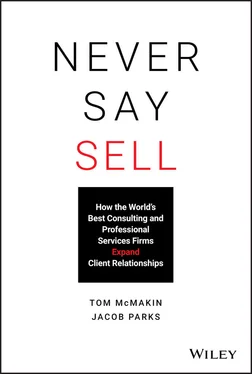Our host describes one of the foundational challenges to growing work within a client: the disconnect between different practice areas or realms of expertise within a company – in his case technology services and business consulting services – between themselves and their client.
The left hand doesn't know what the right hand is doing.
Bloom Where You Are Planted
“(At Deloitte), we were encouraged to do good work,” reports Charlie, “to build great relationships with clients, and to be there when a client has problems so we could offer to help.”
Bill Burch is an accomplished expert services rainmaker, currently driving revenues at ECFx from his home base in Leesburg, Virginia. He says:
There is a totally different way to sell to an existing customer than there is to a new customer. The person who brings in a new account is a sales hunter. They will be highly skilled. They'll know the competition and know how to compete against the competition. Someone who focuses on add-on sales to current clients has a different skillset. In the sales vernacular, they're called farmers.
Peter Bryant of Clareo agrees. “Farmers bring home world-class project delivery and are very good at developing relationships inside the client. It is the reason they get the follow-on work.”
Deloitte knew reaching outside of a client to lasso a new logo is really hard, particularly for more junior people, but they also knew that harvesting add-on opportunities with an existing client is a much higher percentage activity . This is why Deloitte focused Charlie on farming first, urging him “to be there when a client has problems so we could help.”
Our friend who said 80% of his firm's business comes from 20% of his clients described what statisticians call a power-law relationship or the phenomenon of two data sets relating to each other in predictable ways regardless of how the set grows or contracts. Power laws – in this case the inverse relationship between client numbers and revenues – emerge when there is reinforcing feedback. In expert services, that feedback is the hard-to-accumulate, easy-to-destroy twin propellers of trust and credibility. When both are pulling strongly through the wind, we gain institutional momentum: Good work begets more good work and the gigs roll in exponentially.
This book is about how to farm. Farming current clients for new business is attractive for a number of reasons.
Farming Has a Better ROI Than Hunting
Cold business development outreach costs money. Chasing leads from one end of the planet to the other burns jet fuel and exhausts our best people, often with very little to show for it. Writing thought leadership, going to conferences, or buying advertising is even less effective, because it is terribly expensive. It is far better to look closer to home. If you had $25,000 to spend on business development and had the choice between advertising in CEO Magazine for three months or having 50 dinners with clients, you would choose the salmon and Sauvignon Blanc every day of the week. That's because the chances of inking work are much greater when we talk to people who already respect our capabilities and trust us with their businesses.
Dr. Christopher Stevens, a professor at Gonzaga's Graduate School of Business Administration, says,
It's at least six, maybe eight times as expensive to get a new client as it is to keep an existing one … This is especially true if you're doing engagement-based consulting where you go out and learn the client's business. You're building up all of this knowledge base about who they are and what they do. The absolute last thing you'd want to do is squander that by not capitalizing on that intimacy to find other value options for them.
Farming Alerts You to Opportunities Early
When we sit down with clients and have real conversations about where their business is going, we see opportunities to help – sometimes even before they do. The world of business is not mechanical. It's a world where people are busy and distracted, but a world where, every once in a while, we're able to step back with a friend and get some perspective on what we're doing.
“Allison, I love having lunch with you,” your client may say to you as you brainstorm over egg salad sandwiches. “You always ask the best questions. It's helpful. You cause me to have new ideas.”
Being on-site with our clients and getting to the level where we can be open, spill our unperfected thinking out on the table, and hash ideas back and forth, means we are present at the creation. The ideas that come out of this sort of brainstorming are what end up in a buyer's annual budget proposal. Not only are you collaborating pre-RFP (request for proposal), but, importantly, it can be the source of non-RFP work. That's how we get asked to expand our statements of work (SOWs) – to keep digging into the challenges for which we've shown an appetite to help.
Most experts have a story that goes something like this: We were in Bentonville and shared with the team how we had strong capabilities designing customer experience at the point of transaction. We felt we had established rapport with the Walmart team, and they began to talk about how our work might help, particularly in their Mexico stores. But they were slow to follow up. Months turned into quarters and quarters into a year and half. Then we read in the trades that our biggest competitor out of Houston had won a transaction transformation project with them. It wasn't that we were bad. It was just that we weren't the last blue suits in the door.
Being proximate to opportunity matters, and nothing is more proximate than being on the job site. You hear of client challenges first, and you are still there four months later when they are looking to engage.
Reports Charlie,
Deloitte recognized that projects led to new work. I was often involved in M&A [mergers and acquisitions] projects before there was a deal, researching an industry, evaluating a potential acquisition, or running analysis on what a client thought they could do with a company once they acquired it. If they ended up doing the deal, there becomes a host of follow-on work to integrate the two companies. Integration is very complex, and a company can lose a lot of value if anything goes wrong. As a project manager, we would go through a process of asking ourselves what we thought the biggest challenges would be for the client. Would their current technology work or would they need something different? If they were choosing between technologies, would they need help in evaluating which one to use? If there were departments that needed to be cut to drive synergies, which ones should be cut? We'd actively talk about what were the biggest opportunities for Deloitte to help the client with their next phase, and that's what we would talk about when the partner came to the project site, especially toward the end of a project.
Farming Is Less Time Intensive
John Nord, a managing director at PIE, grew up in the small Minnesota town of Owatonna, where his father sold hogs and worked at the grain elevator and his mother was an office manager.
I played hockey day and night. In the winter, my dad and I would flood our machine shed that we had at our place and set up lights and a warming hut. You learn pretty quickly that hockey is a low percentage sport and goals are hard to come by. Scores are often 2 to 1 or even 0 to 0 and that's after an hour of hard play. The trick is to take high percentage shots. Shooting a slapshot from halfway down the rink isn't going to work. Even if you can get one on net, the chances of scoring a goal are slim.
Читать дальше












